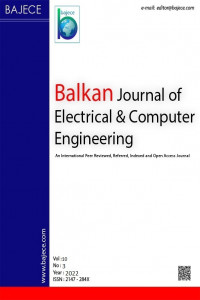Abstract
References
- [1] S. Nakamura, T. Mukia, and M. Senoh, “Candela-class high-brightness InGaN/AlGaN double-heterostructure blue-light-emitting diodes,” Appl. Phys. Lett., vol. 64, p. 1687, 1994.
- [2] S.Muthu, J.Gaines, “Red, green and blue LED-based white light source:implementation challenges and control design”, 38th Conference Record of the IEEE Industry Applications Society Annual Meeting (IAS), 2003.
- [3] Y. Nanishi, “The birth of the blue LED”, Nature Photonics, 2014.
- [4] K.Meel, P. Mahala, “Design and Fabrication of Multi Quantum well based GaN/InGaN Blue LED”, IOP Conference Series Materials Science and Engineering, 2018.
- [5] Q. Dai et. al., “Internal quantum efficiency and nonradiative recombination coefficient of GaInN/GaN multiple quantum wells with different dislocation densities,” Appl. Phys. Lett., vol. 94, 111109, 2009.
- [6] Y.C. Shen, G.O. Mueller, S. Watanabe, N.F. Gardner, A. Munkholm, and M.R. Krames, “Auger recombination in InGaN measured by photoluminescence,” Appl. Phys. Lett., vol. 91, 141101, 2007.
- [7] S. Han, S. Kim, C. Lee, “Blue-Red LED wavelength shifting strategy for enhanging beta-carotene production from halotolerant microalga, Dunaliella Sanila”, Microbial Systematics and Evolutionary Microbiology, 2018.
- [8] C. Xiong, F. Jiang, W. Fang, “The characteristics of GaN-based LED on Si substrate”, Journal of Luminscence, pages 185-187, 2007.
- [9] L. Yu-hong, W. Yo-rong, J. Shang, “Influence of Different Wavelength Blue LED on Human Optical Biorhythm Effect”, 2013 .
- [10] P. Kumar, M. Saheed, Z. Burhanudin, “Performance comparison of one&two quantum wells light emitting diodes simulated with COMSOL Multiphysics”, 6th International Conference on Intelligent and Advanced Systems(ICIAS), 2016.
- [11] R. Xie, Z. Li, S. Guo, “High Bandwidth GaN-based blue LEDs using Ag-grating and diamond heat sink”, Photonics and Nanostructures-Fundamentals and Applications, 2020.
- [12] C. Jia, T. Yu, C. Zhong, “Performance improvement of GaN-based LEDs with step stage InGaN/GaN strain relief layers in GaN-based blue LEDs”, Optics Express, volume 21, 2013.
- [13] L. Deurzen, S. Bharadwaj, “Enhanced efficiency in bottom tunnel junction InGaN blue LEDs”, Light-Emitting Devices, Materials and Applications XXV. Conference, 2021.
- [14] W. Sun, C. Tien, “Optical Modeling Analysis of Red, Green, and Yellow Phosphors with a Blue LED”, Advances in Condensed Matter Physics, volume 2018.
Wavelength tune of InGaN based blue LEDs by changing indium percentage and operational voltage variables
Abstract
Abstract— blue light-emitting-diodes (LEDs) are special and different then the other LEDs due to their high-efficient lighting. They have large badgap energy. So gallium nitrides are mostly used during designing blue light. This application focus on the emission properties of a InGaN LED. The emission intensity, energy diagram, spectrum, and efficiency are calculated for an applied voltage. The indium and GaN composition in the blue LED can be varied to control the emission wavelength. In here, composition of InGaN and operational voltage values were varied to control wavelength. Effects of the different InGaN composition and different voltage values were given in results as comperehansively for 5 different simulations. This study is dissimalar than other wevelength studies due to used original parameter values and wavelength compared methods for many situations about InGaN percentage and volatage values. As a result of simulations, we can infer that the high In_x percentage in composition and high voltage makes wavelength gap of an blue LED larger.
Keywords
References
- [1] S. Nakamura, T. Mukia, and M. Senoh, “Candela-class high-brightness InGaN/AlGaN double-heterostructure blue-light-emitting diodes,” Appl. Phys. Lett., vol. 64, p. 1687, 1994.
- [2] S.Muthu, J.Gaines, “Red, green and blue LED-based white light source:implementation challenges and control design”, 38th Conference Record of the IEEE Industry Applications Society Annual Meeting (IAS), 2003.
- [3] Y. Nanishi, “The birth of the blue LED”, Nature Photonics, 2014.
- [4] K.Meel, P. Mahala, “Design and Fabrication of Multi Quantum well based GaN/InGaN Blue LED”, IOP Conference Series Materials Science and Engineering, 2018.
- [5] Q. Dai et. al., “Internal quantum efficiency and nonradiative recombination coefficient of GaInN/GaN multiple quantum wells with different dislocation densities,” Appl. Phys. Lett., vol. 94, 111109, 2009.
- [6] Y.C. Shen, G.O. Mueller, S. Watanabe, N.F. Gardner, A. Munkholm, and M.R. Krames, “Auger recombination in InGaN measured by photoluminescence,” Appl. Phys. Lett., vol. 91, 141101, 2007.
- [7] S. Han, S. Kim, C. Lee, “Blue-Red LED wavelength shifting strategy for enhanging beta-carotene production from halotolerant microalga, Dunaliella Sanila”, Microbial Systematics and Evolutionary Microbiology, 2018.
- [8] C. Xiong, F. Jiang, W. Fang, “The characteristics of GaN-based LED on Si substrate”, Journal of Luminscence, pages 185-187, 2007.
- [9] L. Yu-hong, W. Yo-rong, J. Shang, “Influence of Different Wavelength Blue LED on Human Optical Biorhythm Effect”, 2013 .
- [10] P. Kumar, M. Saheed, Z. Burhanudin, “Performance comparison of one&two quantum wells light emitting diodes simulated with COMSOL Multiphysics”, 6th International Conference on Intelligent and Advanced Systems(ICIAS), 2016.
- [11] R. Xie, Z. Li, S. Guo, “High Bandwidth GaN-based blue LEDs using Ag-grating and diamond heat sink”, Photonics and Nanostructures-Fundamentals and Applications, 2020.
- [12] C. Jia, T. Yu, C. Zhong, “Performance improvement of GaN-based LEDs with step stage InGaN/GaN strain relief layers in GaN-based blue LEDs”, Optics Express, volume 21, 2013.
- [13] L. Deurzen, S. Bharadwaj, “Enhanced efficiency in bottom tunnel junction InGaN blue LEDs”, Light-Emitting Devices, Materials and Applications XXV. Conference, 2021.
- [14] W. Sun, C. Tien, “Optical Modeling Analysis of Red, Green, and Yellow Phosphors with a Blue LED”, Advances in Condensed Matter Physics, volume 2018.
Details
| Primary Language | English |
|---|---|
| Subjects | Electrical Engineering |
| Journal Section | Araştırma Articlessi |
| Authors | |
| Publication Date | July 30, 2022 |
| Published in Issue | Year 2022 Volume: 10 Issue: 3 |
All articles published by BAJECE are licensed under the Creative Commons Attribution 4.0 International License. This permits anyone to copy, redistribute, remix, transmit and adapt the work provided the original work and source is appropriately cited.


